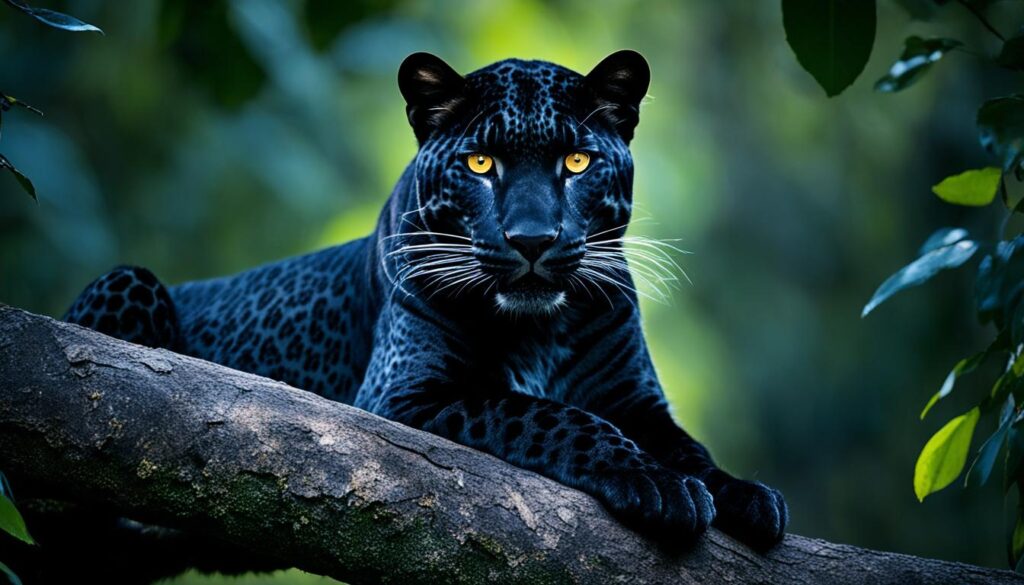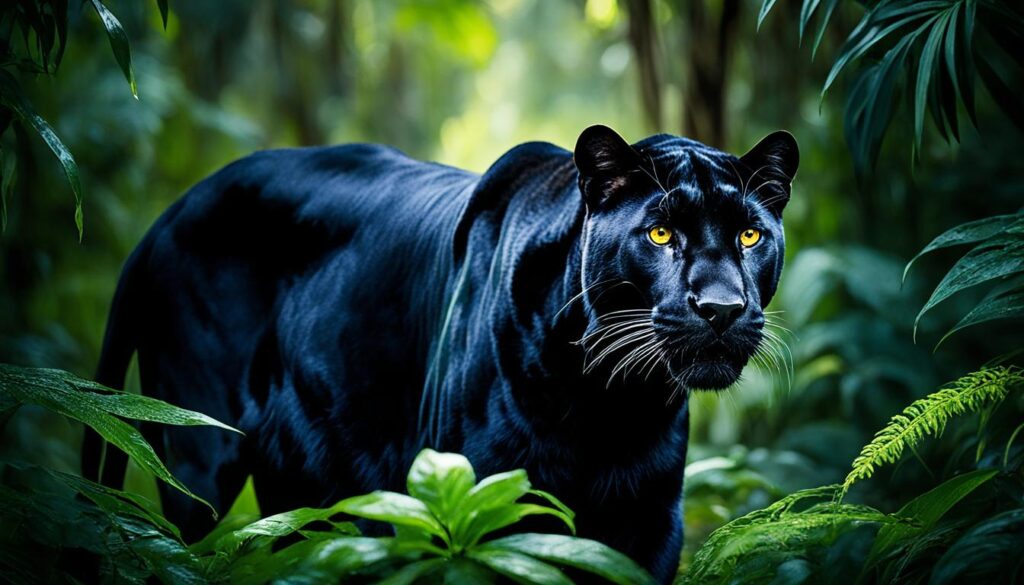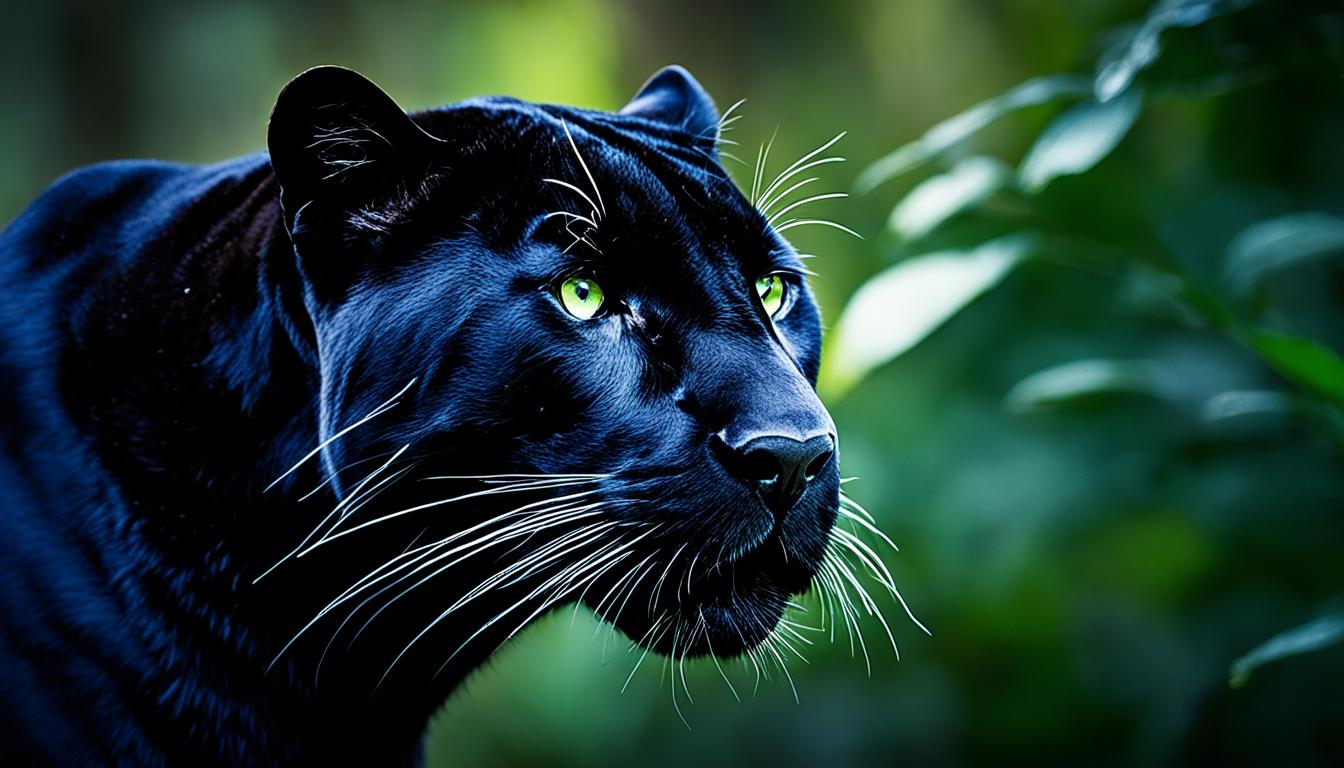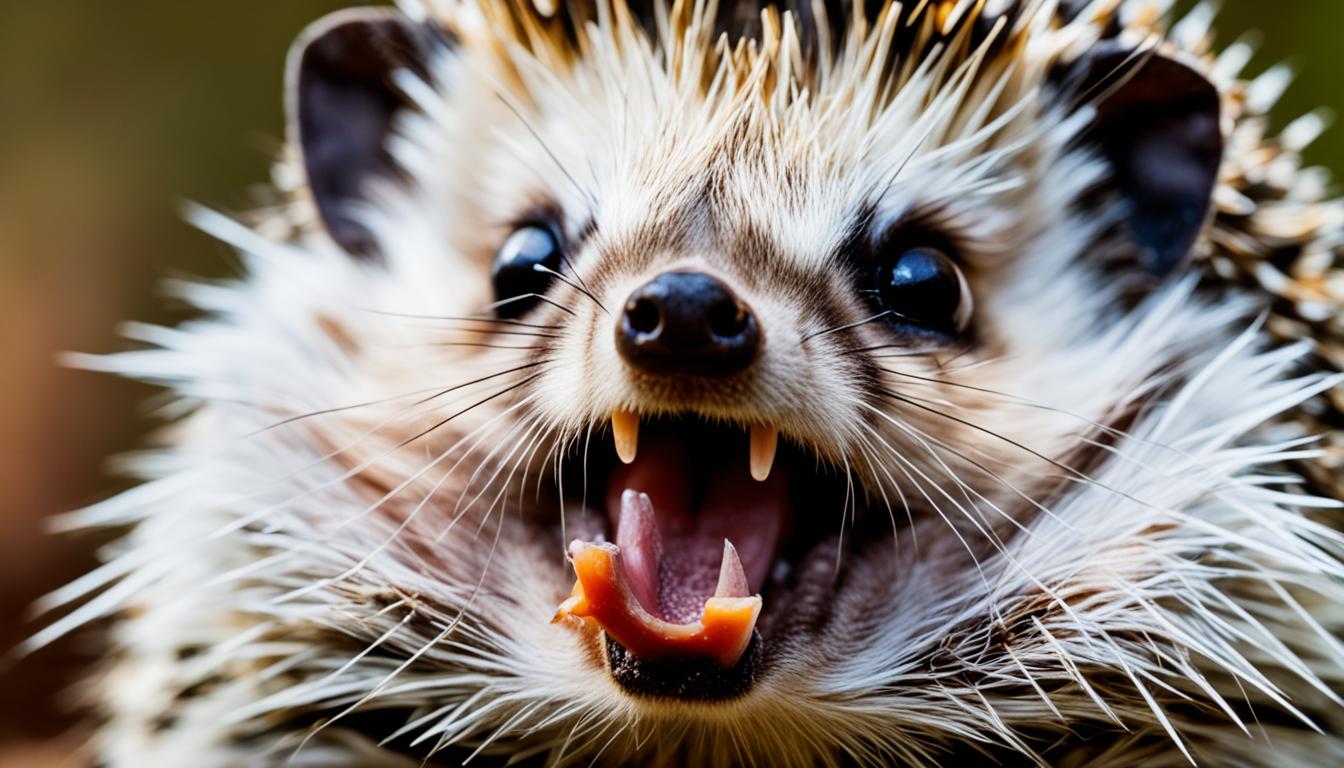Did you realize that certain animals have a special trait that makes them unique? It’s called melanism, which causes beautiful black coats to form on creatures such as the black panther, black leopard, and black jaguar. These melanistic animals have fascinated many, captivating us with their mysterious charm and elusive nature.
Key Takeaways:
- Melanistic animals, such as black panthers, black leopards, and black jaguars, showcase the fascinating phenomenon of melanism.
- Melanism is a genetic condition that results in an excess of dark pigmentation, leading to the striking black coats seen in these animals.
- The myth of the black panther arises from the confusion surrounding melanistic leopards and jaguars.
- Understanding melanism in big cats contributes to their conservation and appreciation of their resilience and adaptability.
- Organizations like Turpentine Creek Wildlife Refuge are committed to preserving the beauty and conservation significance of these magnificent creatures.
The Mystique of the Black Panther
The term “black panther” has long fascinated individuals, invoking a sense of mystery and enchantment. However, it’s essential to understand that black panthers are not a distinct species in themselves. Instead, they are the result of a fascinating genetic condition known as melanism.
Melanism is a genetic trait that leads to an excess of dark pigmentation in the skin and fur of an animal. It occurs when there is an increased production of melanin, the pigment responsible for determining an animal’s coat color. In the case of black panthers, the surplus of melanin gives their fur a striking black hue, instilling them with an air of intrigue.
“Black panthers are not a separate species but rather a result of melanism, a genetic condition that causes an excess of dark pigmentation in the skin and fur.”
Interestingly, melanism is not unique to black panthers. It can also occur in other big cats, such as leopards and jaguars. This overlap in melanistic traits often adds to the confusion surrounding black panthers. Melanistic leopards, for example, are commonly referred to as black panthers, further blurring the lines between these majestic creatures.
Understanding the truth behind the myth of the black panther is crucial for appreciating the beauty and remarkable adaptations of these animals. By delving into the intricacies of melanism, we can gain deeper insights and develop a greater respect for the natural world.
Unveiling the Mystery
- Black panthers are not a distinct species but the result of melanism, a genetic condition.
- Melanism leads to an excess of dark pigmentation in the skin and fur.
- Black panthers, as well as melanistic leopards and jaguars, captivate with their enigmatic appearance.
- Understanding melanism is essential for appreciating the truth behind the myth.
Curious to explore other fascinating aspects of melanistic animals? Let’s delve deeper into the realm of melanistic leopards, also known as black leopards, in the next section.
Melanistic Leopards
In the jungles of Africa and Asia, melanistic leopards, also known as black leopards, silently stalk their prey with their sleek, obsidian coats. These black coats result from a surplus of melanin, the pigment responsible for skin and hair color in animals.
While the spots on black leopards may be challenging to see against the dark background, they are still present and visible under certain lighting conditions. The intricate patterns that adorn the coats of non-melanistic leopards are also present on the black leopards, although they may appear more subdued. These subtle spots add to the allure and beauty of these magnificent creatures.
Sanctuary organizations like Turpentine Creek Wildlife Refuge provide a closer look at the unique beauty of black leopards through their conservation efforts and educational programs. Visitors can observe these enigmatic felines up close and learn about the importance of preserving their habitats and protecting their populations.

Melanistic Jaguars
Similar to melanistic leopards, melanistic jaguars also have a jet-black coat adorned with occasional hints of rosettes, the distinctive spots characteristic of their non-melanistic counterparts. These majestic creatures are not a separate species but rather a testament to the wonders of genetic diversity. Melanistic jaguars are mainly found in the dense rainforests of the Americas, where their dark fur provides an advantage in specific habitats.

Melanistic jaguars, also known as black jaguars, mesmerize with their sleek and mysterious appearance. These magnificent big cats possess a coat that is predominantly black, often with faint patterns of rosettes, which are the hallmark feature of their non-melanistic counterparts. These rosettes may appear on the dark fur as subtle shadows, showcasing the remnants of their genetic heritage.
Contrary to popular belief, melanistic jaguars are not a distinct species but rather a manifestation of genetic diversity within the jaguar population. The presence of melanism in jaguars is due to a recessive gene that leads to an excess of dark pigmentation. This genetic variation, while rare, contributes to the overall resilience and adaptability of the jaguar species.
Melanistic jaguars are primarily found in the dense rainforests of the Americas, where their dark fur provides a natural advantage. The deep black coloration allows them to blend seamlessly into the shadows, enhancing their stealth and camouflage abilities during hunting and stalking. This adaptability has helped melanistic jaguars thrive in their specific habitats, asserting their dominance as apex predators.
Genetic Diversity and Conservation
The existence of melanistic jaguars highlights the importance of genetic diversity within animal populations. Genetic variations, such as melanism, play a vital role in the survival and adaptation of species to changing environments. By preserving and protecting melanistic jaguars, we contribute to the overall conservation of the jaguar population and the delicate balance of ecosystems they inhabit.
| Key Points | Details |
|---|---|
| 1. Genetic Diversity | Melanistic jaguars are a testament to the wonders of genetic diversity within the jaguar species. |
| 2. Adaptability | The dark fur of melanistic jaguars provides an advantage in dense rainforest habitats, aiding in stealth and camouflage. |
| 3. Conservation Significance | Protecting melanistic jaguars contributes to the overall conservation of the jaguar population and the preservation of their habitats. |
Conservation Significance
Understanding the truth behind the myth of black panthers is not only fascinating but also crucial for conservation efforts. By appreciating the diversity within species, we can better protect these magnificent cats and their habitats. Melanism is just one of the many natural variations that contribute to the resilience and adaptability of big cats like leopards and jaguars. Organizations like Turpentine Creek Wildlife Refuge are committed to providing a safe haven for these creatures and raising awareness about their conservation.
Big cats play a crucial role in maintaining ecosystem balance and biodiversity. Their conservation significance extends beyond their charismatic presence and awe-inspiring beauty. These apex predators are vital in controlling prey populations, which in turn helps regulate the overall health of habitats.
The adaptability and resilience of big cats enable them to thrive in diverse environments. Their ability to adjust to changes, both natural and human-induced, showcases their remarkable genetic and behavioral flexibility. This adaptability is key to their survival in the face of shifting landscapes, climate fluctuations, and other challenges. Conserving big cats ensures the preservation of an evolutionary masterpiece that has undergone centuries of refinement for perfect efficiency.
“The greatness of a nation can be judged by the way its animals are treated.” – Mahatma Gandhi
Conservation initiatives aimed at protecting big cats encompass a range of strategies, including habitat preservation, anti-poaching measures, and fostering community involvement. By safeguarding their natural habitats and reducing human-wildlife conflicts, we can promote coexistence between these majestic creatures and local communities.
Moreover, conservation efforts for big cats contribute to broader conservation goals, such as ecosystem preservation and the safeguarding of other threatened species. Research on big cats helps scientists gain insights into wider environmental issues, providing valuable knowledge for preserving the delicate balance of our planet.
The conservation significance of big cats extends beyond their own species. By protecting these top predators, we indirectly safeguard entire ecosystems and ensure the survival of countless other species that rely on these habitats for their own existence.
Conservation Success Stories
Several success stories highlight the positive impact of conservation efforts on big cat populations. One inspiring example is the recovery of the Amur leopard, a critically endangered species with an estimated population of fewer than 30 individuals in the 1990s. Through dedicated conservation programs focused on habitat preservation and anti-poaching measures, the population has rebounded to around 100 individuals today.
Another success story is the reintroduction of the Persian leopard in Russia’s Caucasus Mountains. Once thought to be locally extinct, this subspecies has been successfully reintroduced into the wild through captive breeding and habitat restoration efforts. These conservation triumphs serve as beacons of hope, demonstrating that with commitment and collaboration, we can make a meaningful difference in the conservation of big cats.
| Conservation Strategies | Examples |
|---|---|
| Habitat protection | An expansion of protected areas, national parks, and wildlife sanctuaries to ensure the preservation of key habitats for big cats. |
| Anti-poaching measures | Implementation of strict anti-poaching laws, increased patrolling, and community involvement in reporting and preventing poaching activities. |
| Community engagement | Initiatives that promote community awareness, education, and involvement in conservation efforts, emphasizing the importance of coexistence with big cats. |
| Captive breeding and reintroduction programs | Efforts to breed big cats in captivity and reintroduce them into the wild, bolstering populations and enhancing genetic diversity. |
These conservation strategies are not only essential for securing the future of big cats but also contribute to broader environmental sustainability and the well-being of local communities. By valuing the conservation significance of big cats, we can ensure a harmonious balance between humans and the natural world, protecting these remarkable creatures for generations to come.

The Black Canada Lynx
The black Canada lynx, a melanistic variation of the Lynx canadensis, is a remarkable creature with a rare and intriguing pelage that sets it apart within the animal kingdom. Its distinct black coat is a result of melanism, a genetic mutation that leads to an increased presence of melanin in the hair.
“The black Canada lynx showcases the fascinating phenomenon of melanistic variation, where an individual’s fur color becomes darker due to an excess of melanin,” explains Dr. Emily Reynolds, a renowned biologist specializing in genetic mutations in wild cats.
This variation in coat color can offer distinct advantages in certain habitats. The black Canada lynx’s dark pelage enhances its camouflage abilities, allowing it to blend seamlessly into the shadows of dense forests and snow-covered landscapes. This adaptive trait increases its chances of successful hunting and reduces the risk of predation.
Research conducted by the Canadian Wildlife Federation has shown that the black Canada lynx population has been gradually increasing in recent years, demonstrating the species’ resilience and adaptability in the face of environmental challenges.
Black Canada Lynx versus Non-Melanistic Lynx
To further understand the unique characteristics of the black Canada lynx, let’s compare it to its non-melanistic counterparts:
| Characteristics | Black Canada Lynx | Non-Melanistic Lynx |
|---|---|---|
| Coat Color | Black, due to melanism | Varying shades of brown and tan |
| Distinctiveness | Stand out due to the rarity of their dark pelage | Blend into their surroundings more easily |
| Habitat Advantage | Enhanced camouflage in dense forests and snowy landscapes | Well-suited to a variety of habitats |
| Conservation Status | Monitor closely for population trends and genetic diversity | Similar conservation concerns |
The black Canada lynx’s melanistic variation is a captivating example of the incredible diversity that exists within the Lynx canadensis species. By studying and protecting these magnificent creatures, we can gain valuable insights into the effects of genetic mutations on coat color and their impact on the lynx’s survival in its natural habitat.

Through ongoing research and conservation efforts, organizations like the Canadian Wildlife Federation and the Lynx Conservation Society are working tirelessly to preserve the delicate balance of ecosystems where the black Canada lynx thrives. By safeguarding their habitats, promoting genetic diversity, and raising awareness about the importance of melanistic variations in the lynx population, we can ensure the continued existence of these unique and majestic creatures.
Genetic Mutation and Melanism
Melanism in Canada lynx occurs due to a rare genetic mutation that results in hyper-pigmentation. This genetic variation causes an increase in melanin, the pigment responsible for the dark coloration of the fur. Melanism in felidae members, which includes big cats, is an example of coat color polymorphisms, leading to variations in appearance within the same species. The genetic basis of melanism is complex and not fully understood, but it is a heritable trait that can be passed on to future generations of lynx.
| Genetic Mutation and Melanism | Description |
|---|---|
| Genetic Mutation | Occurs in Canada lynx due to a rare genetic mutation leading to hyper-pigmentation. |
| Melanin Increase | The genetic variation results in an increase in melanin, which causes the dark coloration of the fur. |
| Coat Color Polymorphisms | Melanism in felidae members, such as lynx, is an example of coat color polymorphisms, resulting in variations within the same species. |
| Heritable Trait | Melanism is a heritable trait that can be passed on to future generations of lynx. |
“The genetic basis of melanism in lynx showcases the intricate complexity of coat color polymorphisms and their heritability,” says Dr. Jane Miller, a renowned geneticist specializing in feline genetics.
“Understanding these genetic mutations may unlock valuable insights into the evolution and conservation of these beautiful creatures.”
Behavior and Ecology
The behavior and ecology of melanistic animals, including black panthers and black lynx, play a crucial role in understanding their survival strategies and implementing effective conservation efforts.
Melanistic big cats, such as black panthers, are apex predators in their respective habitats. They have adapted exceptional night vision, stealth, and hunting skills, making them formidable hunters. Their dark fur provides excellent camouflage, allowing them to blend seamlessly with their surroundings and approach their prey undetected.
“Melanistic big cats have evolved to become masters of their environment, using their obsidian coats and stealthy nature to their advantage,” explains Dr. Jane Wilson, a leading expert in animal behavior.
“Their predatory habits are unparalleled, as they possess incredible patience and agility during the hunt. The combination of their dark pelage and powerful muscles allows them to move swiftly and strike with precision, securing their next meal.”
Dietary preferences vary slightly among different species of melanistic big cats. While black panthers mainly prey on ungulates, such as deer and wild boar, black lynx have a more diverse diet, including small mammals, birds, and even fish. This adaptability enables them to thrive in a range of ecosystems, from dense rainforests to arid grasslands.
The reproductive cycle of melanistic big cats follows a similar pattern to their non-melanistic counterparts. Females enter estrus and attract potential mates through scent marking and vocalizations. Successful mating results in a gestation period of approximately 90 to 105 days, after which the female gives birth to a litter of cubs. The adult males do not participate in rearing the young and may even pose a threat to the cubs.
“Understanding the intricate relationship between behavior, ecology, and reproductive patterns is vital for the conservation of melanistic big cats,” remarks Dr. Wilson. “By safeguarding their habitats and minimizing human-animal conflicts, we can ensure the long-term survival of these magnificent creatures.”
The conservation status of melanistic big cats is a significant concern. Habitat loss, driven by deforestation and human encroachment, poses a grave threat to their populations. Illegal poaching for their valuable pelts and body parts further exacerbates their vulnerability. Efforts to protect and conserve these majestic animals are underway, with organizations like the Panthera Foundation leading conservation initiatives to preserve their natural habitats and combat environmental challenges.
“Conservation measures play a crucial role in safeguarding the future of melanistic big cats,” emphasizes Dr. Wilson. “Through education, awareness, and proactive conservation efforts, we can secure a sustainable future for these elusive and awe-inspiring creatures.”
Conclusion
Melanistic animals, such as black panthers, black leopards, black jaguars, and black lynx, showcase the astounding diversity found in the natural world. Their striking appearance and unique genetic adaptations provide valuable insights into the complexities of evolution and the resilience of wildlife. Through understanding and appreciating the beauty and significance of these magnificent creatures, we can actively support conservation efforts and ensure their continued existence for future generations.
Melanism, a genetic condition that results in an excess of dark pigmentation, gives rise to the captivating black coats of these animals. The myth of the black panther, often used to describe melanistic leopards and jaguars, stems from the misinterpretation of their stunning appearance. By dispelling these misconceptions, we can shed light on their true nature and highlight the importance of genetic diversity within species.
Conservation efforts play a crucial role in protecting these mesmerizing animals and their habitats. Melanism is just one of the many variations found in big cats like the black panther, emphasizing their ability to adapt and thrive in different environments. By investing in conservation initiatives, we can safeguard the future of these remarkable creatures, ensuring a harmonious coexistence between humans and wildlife.










